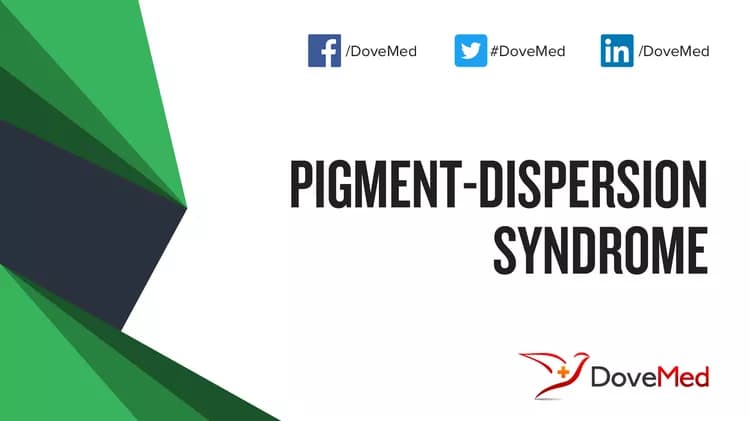What are the other Names for this Condition? (Also known as/Synonyms)
- PDS (Pigment-Dispersion Syndrome)
What is Pigment-Dispersion Syndrome? (Definition/Background Information)
- Pigment-Dispersion Syndrome is an eye disorder that occurs when pigment granules that normally adhere to the back of the iris (the colored part of the eye) flake off into the clear fluid produced by the eye (aqueous humor)
- These pigment granules may flow towards the drainage canals of the eye, slowly clogging them and raising the pressure within the eye (intraocular pressure or IOP)
- This rise in eye pressure can cause damage to the optic nerve (the nerve in the back of the eye that carries visual images to the brain). If the optic nerve becomes damaged, pigment-dispersion syndrome becomes pigmentary glaucoma
- Pigment-Dispersion Syndrome commonly presents between the second and fourth decades, which is earlier than other types of glaucoma. While men and women are affected in equal numbers, men develop pigmentary glaucoma up to 3 times more often than women
- Myopia (nearsightedness) appears to be an important risk factor in the development of Pigment-Dispersion Syndrome and is present in up to 80% of affected individuals
- The condition may be sporadic or follow an autosomal dominant pattern of inheritance with reduced penetrance
- Pigment-Dispersion Syndrome can be treated with eye drops or other medications. In some cases, laser surgery may be performed
(Source: Pigment-Dispersion Syndrome; Genetic and Rare Diseases Information Center (GARD) of National Center for Advancing Translational Sciences (NCATS), USA.)
Who gets Pigment-Dispersion Syndrome? (Age and Sex Distribution)
- Pigment-Dispersion Syndrome is a rare disorder that may be a sporadic or congenital
- The presentation of symptoms typically occurs between the ages of 10 and 40 years
- Both males and females may be affected, although the condition is predominant in males (3:1 male-female ratio)
- Worldwide, individuals of all racial and ethnic groups may be affected. However, the condition is more prevalent in Caucasians
What are the Risk Factors for Pigment-Dispersion Syndrome? (Predisposing Factors)
The risk factors for Pigment-Dispersion Syndrome may include:
- A family history of the condition
- Being short-sighted (myopic)
- Male gender
It is important to note that having a risk factor does not mean that one will get the condition. A risk factor increases one’s chances of getting a condition compared to an individual without the risk factors. Some risk factors are more important than others.
Also, not having a risk factor does not mean that an individual will not get the condition. It is always important to discuss the effect of risk factors with your healthcare provider.
What are the Causes of Pigment-Dispersion Syndrome? (Etiology)
- Pigment-Dispersion Syndrome may develop sporadically, or be caused by inherited genetic mutation(s)
- The exact gene mutation that causes this syndrome, however, is not known. A specific locus on chromosome 7 is associated with its development
- The inherited form of this disorder follows an autosomal dominant pattern, with reduced penetrance
Autosomal dominant mode of inheritance: Autosomal dominant conditions are traits or disorders that are present when only one copy of the mutation is inherited on a non-sex chromosome. In these types of conditions, the individual has one normal copy and one mutant copy of the gene. The abnormal gene dominates, masking the effects of the correctly function gene. If an individual has an autosomal dominant condition, the chance of passing the abnormal gene on to their offspring is 50%. Children, who do not inherit the abnormal gene, will not develop the condition or pass it on to their offspring.
In autosomal dominant inheritance with reduced or incomplete penetrance, an individual may not develop symptoms even when he/she is carrying a defective gene copy in each cell of his/her body. It is believed that factors other than gene mutation(s) contribute to the development of the disease
What are the Signs and Symptoms of Pigment-Dispersion Syndrome?
The signs and symptoms of Pigment-Dispersion Syndrome may vary in severity among affected individuals. While some of those affected may be asymptomatic, others may present with the following signs and symptoms:
- Blurring of vision
- Seeing halos
- Increased intra-ocular pressure
- Occurrence of clear/blank spots in the field of vision
How is Pigment-Dispersion Syndrome Diagnosed?
Pigment-Dispersion Syndrome is diagnosed on the basis of the following information:
- Complete physical examination
- Thorough medical history evaluation
- Assessment of signs and symptoms
- Laboratory tests
- Imaging studies
- Biopsy studies, if necessary
- Regular eye exam, which may include checking for floating pigment in the eyes and gonioscopy, to check the status of drainage from the eye
Many clinical conditions may have similar signs and symptoms. Your healthcare provider may perform additional tests to rule out other clinical conditions to arrive at a definitive diagnosis.
What are the possible Complications of Pigment-Dispersion Syndrome?
The complications of Pigment-Dispersion Syndrome may include:
- Progression to pigmentary glaucoma
- Vision impairment
- Blindness
Complications may occur with or without treatment, and in some cases, due to treatment also.
How is Pigment-Dispersion Syndrome Treated?
There is no cure for Pigment-Dispersion Syndrome, if it is an inherited condition. The treatment is usually given to manage the signs and symptoms and any complication that develops. If increased intra-ocular pressure or pigmentary glaucoma has developed, the following treatment methods for this may be necessary:
- Prescription eye drops
- Laser surgery
- Trabeculoplasty to improve drainage in the eyes
- Laser iridotomy to reduce floating pigment amounts in the eyes and control intra-ocular pressure in the initial stages of pigmentary glaucoma
- Conventional surgery
- Trabeculectomy to reduce pressure within the eye
- Glaucoma drainage devices
How can Pigment-Dispersion Syndrome be Prevented?
Currently, Pigment-Dispersion Syndrome may not be preventable, if it is an inherited disorder. The exact cause of the sporadic disorder is not known, and no preventive methods are available at the present time
- If there is a family history of the condition, then genetic counseling will help assess risks, before planning for a child
- Active research is currently being performed to explore the possibilities for treatment and prevention of inherited and acquired genetic disorders
Regular eye examinations at periodic intervals with relevant tests are recommended.
What is the Prognosis of Pigment-Dispersion Syndrome? (Outcomes/Resolutions)
- The prognosis of Pigment-Dispersion Syndrome is dependent upon the severity of the signs and symptoms and associated complications, if any
- Individuals with mild conditions have better prognosis than those with severe symptoms and complications
- If the condition progresses to pigmentary glaucoma with severe optic nerve damage, blindness may ensue
Additional and Relevant Useful Information for Pigment-Dispersion Syndrome:
The following DoveMed website link is a useful resource for additional information:
Related Articles
Test Your Knowledge
Asked by users
Related Centers
Related Specialties
Related Physicians
Related Procedures
Related Resources
Join DoveHubs
and connect with fellow professionals


0 Comments
Please log in to post a comment.